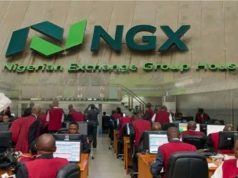SAT, MAY 16 2020-theG&BJournal- The domestic bourse retreated this week, after two consecutive weeks of gains, as the All-Share Index declined by 0.1% w/w, to settle at 23,871.33 points. The loss is attributed to profit-taking by investors in DANGCEM (-4.3%) and MTNN (-2.2%). Thus, the MTD return reduced to +3.7%, as the YTD loss increased to -11.1%. Sectoral performance this week was broadly negative, following losses in the Industrial Goods (-2.2%), Insurance (-0.6%) and Banking (-0.0%) indices. The Consumer Goods (+2.3%) and Oil & Gas (+1.6%) indices recorded the only gains.
‘’In our opinion, risks remain on the horizon due to a combination of the increasing number of COVID-19 cases in Nigeria and weak economic conditions. Thus, we continue to advise investors to trade cautiously and seek trading opportunities in only fundamentally justified stocks,’’ says Cordros Research.
The overnight (OVN) rate contracted by 491bps, w/w, to 3.4%. The OVN started the week higher (9.6%) from last week’s close (8.3%), following the strained liquidity in the system. However, inflows from OMO (NGN209.05 billion) maturities outweighed outflow from NTB auction (NGN142.76 billion) debits, thereby leading to the eventual contraction in the OVN.
We expect the OVN to expand in the coming week, as the week’s inflow from FGN bond coupon payments (NGN17.87 billion) may not be sufficient to improve liquidity in the system.
Trading in the Treasury bills secondary market was bullish following improved (1) demand from local participants and FPIs awaiting US dollar supply from the CBN and (2) trading activity in the NTB secondary market, following this week’s PMA. Thus, the average yield across all instruments contracted by 126bps to 6.6%. Across the segments, average yields contracted at the OMO and NTB markets by 163bps and 38bps to 8.5% and 2.3%, respectively. At this week’s NTB PMA, the DMO took advantage of the high subscription levels, as it fully allotted NGN142.76 billion worth of bills – NGN19.78 billion of the 91-day, NGN40.09 billion of the 182-day and NGN82.89 billion of the 364-day – at respective stop rates of 2.50% (previously 1.85%), 2.85% (previously 2.50%), and 3.84% (previously 3.84%).
In the coming week, we expect demand for T-bills to worsen, as system liquidity may become tight in the week.
Trading in the Treasury bonds secondary market remained bearish, as investors continue to evaluate the current economic landscape to gauge market direction. Accordingly, the average yield expanded by 33bps to 10.6%. Across the benchmark curve, yields expanded at the short (+78bps), mid (+10bps), and long (+7bps) segments following sell-offs of the APR-2023 (+88bps), JUL-2030 (+31bps) and JUL-2034 (+31bps) bonds.
We expect investors’ focus to shift to next week’s PMA, wherein the DMO will offer NGN60.00 billion across three instruments to investors through re-openings – 12.75% APR-2023, 12.50% MAR-2035, and 12.98% APR-2050 bonds. Nonetheless, we still expect some activity at the secondary market as investors cover for lost bids at the auction.
As with the prior week, Nigeria recorded another FX reserve buildup, with the country’s external balance growing by USD612.35 million WTD to USD34.91 billion (8th of May 2020). We attribute the driver of the reserve accretion to the inflow of RFI facility by the IMF. Consequently, the Naira appreciated against the USD by 0.32% w/w to NGN386.00/USD at the I&E window but slid by 2.89% w/w to NGN450.00/USD in the parallel market. In the Forwards market, the naira gained ground against the USD across all contracts. Precisely, the 1-month (+0.2% to NGN388.48/USD), 3-month (+0.2% to NGN392.48/USD), 6-month (+0.2% to NGN398.37/USD), and 1-year (+0.1% to NGN416.77/USD) contracts all declined in value.
Cordros Research sas: ‘’While we still hold the view that the RFI inflow will continue to provide short-term support for the FX reserves, we expect the currency market to remain largely volatile, especially as the CBN has announced the resumption of FX sales to SMEs and for the payment of school fees, in anticipation of the gradual re-opening of the economy.’’
Meanwhile, the National Bureau of Statistics is expected to release data for Nigeria’s consumer price index for April early next week and our view for inflation trajectory hasn’t changed much since our last update.
Recall that headline inflation rose by 7bps to 12.26% y/y (Cordros’ est.: 12.20% y/y) in March, which may be attributed to the unfavourable base from the corresponding period of last year. For the sake of clarity, lower energy prices, especially in H1-19, had driven focal temperance across both the food and core baskets.
For April, against the rising cases of COVID-19 in Nigeria, President Buhari, at the twilight of March, announced lockdowns in Lagos, Abuja, and Ogun in an attempt to flatten the curve of new cases. From our channel checks, we understand that the impact of the preceding stoked upward pressure on food prices in April, owing to the disruption of the supply chain in the agriculture sector and frontloading of food items purchases by consumers.
Already in March, we saw evidence of price pressure in Ogun (Food inflation: +130bps y/y) and Abuja (Food inflation: +80bps y/y), occasioned by the lockdown-induced price increases. Thus, food inflation is expected to grow faster in April by 16bps to 1.10%m/m. Elsewhere, we understand that the FGN has further downwardly revised PMS pump price by another 1.2% m/m, due to lower global oil prices.
While the foregoing should have ordinarily impacted the core basket favourably, we believe further FX depreciation at the I&E window and parallel market will bleed over to the core basket in April, and thus, neuter gains from lower PMS prices.
On balance, core inflation is expected to print 0.83% m/m – 3bps higher than the previous month. Overall, headline inflation is expected to print 0.98% m/m, cascading into 12.30% y/y in April 2020.-With Cordros Research
|twitter:@theGBJournal|email: info@govandbusinessjournal.com.ng|
Home Companies&Markets Weekly Markets Wrap: Domestic bourse stung by Profit-taking in DANGCEM and MTNN,...









